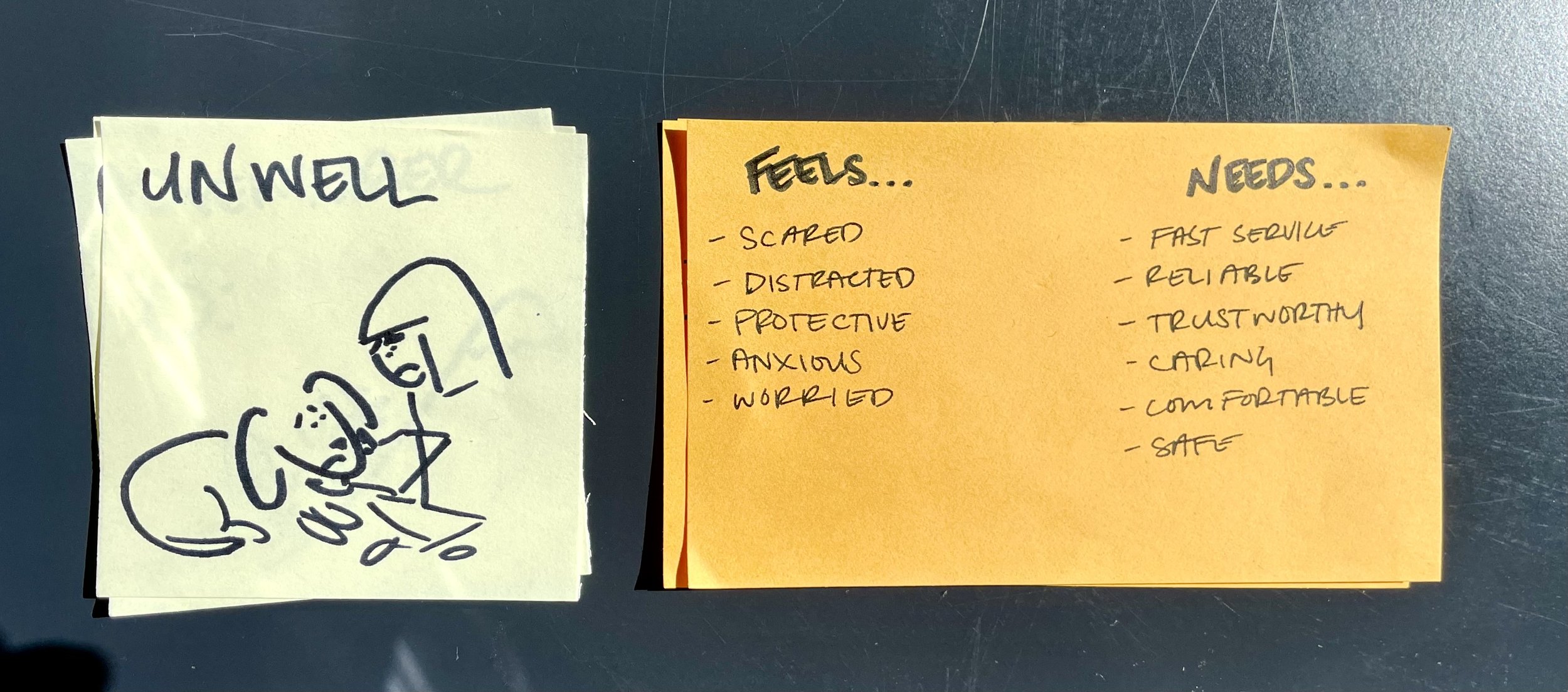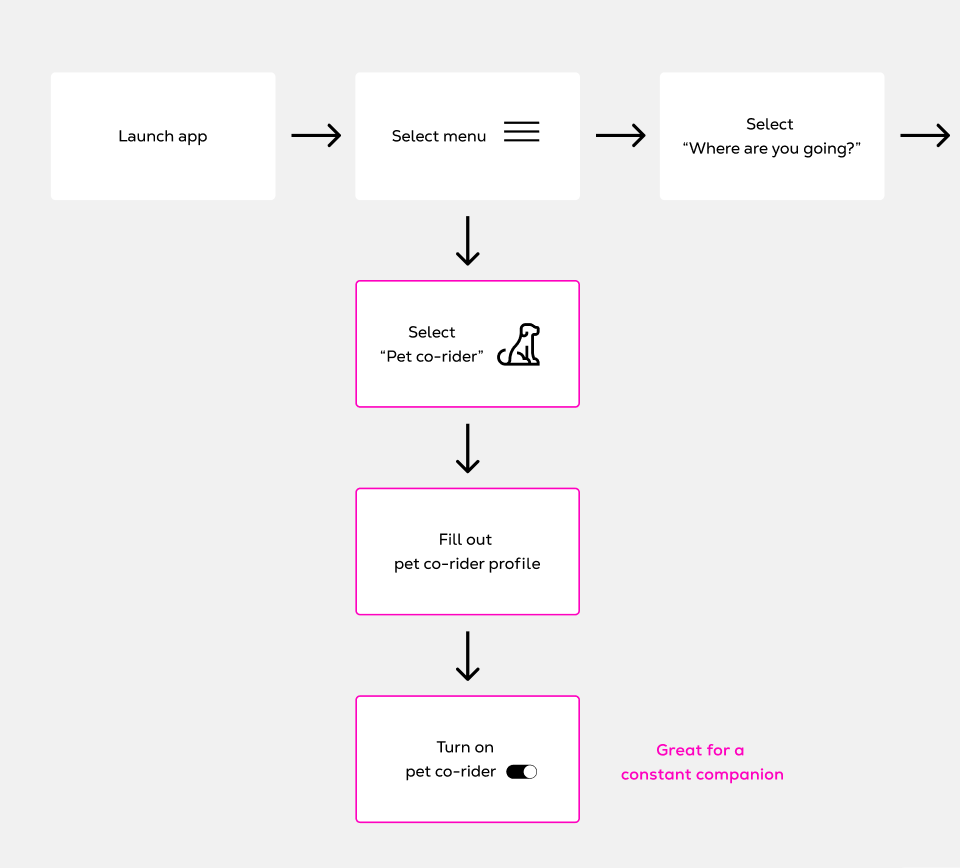Lyft Pet Co-rider Personal Project
Brief
Note: This is a 2022 personal design project 👩🏻🎨
Lyft is a ride-share app that allows service animals for all rides and pets at the driver’s discretion. How might we improve the communication between riders with pets and drivers? As a pet parent myself, I’d like to do better than adding a note while requesting a ride. My solution presents as a mixed mid-fidelity flow (leverages product screenshots) with new ride request UX that includes:
Dog profile
Add dog rider
Add saved note
Driver preview of dog co-rider in request
Role: content and UX designer
Worked with: PM friend to review low fidelity flow
Flow walk-through
This video shows what it’s like to see a flow walk-through midway through the design process. It could be for a mix of stakeholders from design colleagues to eng to leadership. If I were asking for feedback, I’d state specifically what I was and wasn’t looking for.
Note: This was not a “one-take Osmonds” situation. It’s literally me in my closet verbally toddling through something no one asked me to make. Thanks for bearing with me.
Context
Goals
Rider
Get a ride with dog quickly and reach destination.
Match only with drivers that allow pets.
Easily communicate with driver.
Driver
Only see potential pet riders if they accept pets.
Bet set up for success to accommodate pet riders.
All: Be safe and have boundaries respected.
Assumptions & constraints
Scope to mid fidelity rider experience on iPhone.
This is an existing rider (Max) that has not added their dog (Taters).
Max knows how to activate the new dog co-rider feature and does so while requesting a ride.
Re-use as much existing UI that’s visible in the app today.
Solution
I modified the existing flow to allow riders to create a dog profile that communicates to drivers about the dog size, personality, and coat when a ride is requested. Dogs are easily added to rides and notes can be re-used for quick communication with drivers.
User empathy
I thought about the different reasons why people bring their dogs in Lyfts and what they might be feeling in each situation. This helped me clarify their priorities and pain points.
My dog is my constant companion, I’m living my life with them, and I don’t give riding together a second thought.
My dog is sick, I’m worried, and we need to get to the vet right away.
My dog needs to play, I want to get out of the neighborhood, and we’re ready to have fun.
User stories
When booking a ride, I want to know my driver’s comfortable with dogs so I can focus on the destination and relax on the way.
When adding a note, I want to re-use one I wrote before, so I can save time.
Priorities
Get a safe and dog-friendly ride.
Get to my desintation quickly.
Pay a fair rate.
Have a comfortable ride.
Pain points
Having enough space for the dog.
Unknown driver boundaries around dog interactions.
Having a ride cancelled because the driver didn’t read the note or is surprised by the dog.
Potentially damaging or dirtying the car, adding up to fees.
Entry points
Since a ride request flow already exists, I considered logical entry points for the new pet rider UX. I started by mapping the existing user journey, then adding potential new steps (magenta).
Tradeoffs, Reflections, & vNext
Rider flow vs. rider and driver flow
I needed to scope the experience down to be able to balance a side project with, well, life. The reality is the driver’s experience is just as critical as the rider’s because communication is a dance between two people. There’s all sorts of driver considerations, like:
Should pet rides earn more?
Can we make a welcome kit to becoming a pet-friendly driver, including handy things like lint rollers for pet hair and hypoallergenic dog treats?
How glance-able is the new ride request information?
I had the great pleasure of talking through ideas with a driver after designing this experience. This ease of access to user interviews is one of the many thrilling things about ride-share apps. I’m sure there’s more rigor than this for research at Lyft and the insights they bring into the product development flow are invaluable.
Fuller rider flow with mixed fidelity vs. clarity with time
The flow would be clearer if I took the time to remake screen shotted screens so the flow was all at medium fidelity.
vNext: MVP vs. complete functionality
Realistically, this many additions to an existing flow would require a phased approach (see V1-3 images below). The lowest hanging fruit is implementing saved notes. Everyone can get use out of it, not just pet parents. Next would be adding a simplified pet profile, so you could add a dog to your ride with perhaps a picture and name but no details. The biggest effort would be implementing the whole dog profile and how it’s communicated to the driver.
Extensibility
Realistically, pet riders may be a small potatoes problem, but! This kind of consideration for special rides could be applied to everything from small business errands to neurodiverse families. I think about my friend’s kid that has autism and is easily overstimulated—could we help that parent communicate easily in advance to turn the music off? I also think about the hustle of running a chocolate business, and how sometimes I really needed all the trunk space for equipment and supplies. How might we be more thoughtful about making rides easier for everyone?
Screens
The video walk-through gives the best sense of the UX, but here’s a static screen overview of the entire flow.
First time dog profile creation with education toast
Dog profile creation
Adding dog to ride
Adding auto-saved notes
Driver view of dog co-rider request
Sketches and notes
Frankly, it’s past my bed time. I’d love to talk more process during a portfolio review. For now, please enjoy an assortment of sketches and notes from this project. I enjoyed the work quite a lot.
Fun fact 🐶
San Francisco, population 865,000, has roughly the same number of dogs as children: 120,000. In many areas of the city, pet grooming shops seem more common than schools. —NYT 2017
I can’t remember if this is a direct quote or paraphrasing. Please don’t call the quote police on me.



























